Abstract
Normal subjects and Parkinsonian patients performed a bimanual load lifting task. In this task, one "postural" forearm, held in a horizontal position while supporting a 1 kg weight, was unloaded either by the experimenter's hand (imposed unloading) or by the subject's other hand in response to a tone burst (voluntary unloading). The variables recorded were reaction time (RT: time interval between the tone and beginning of unloading) and movement time (MT: duration of the change in force measured by a force platform on the "postural" forearm). Elbow angle changes were also measured with a potentiometer. The EMG activity from brachioradialis of the "postural" arm and that from the biceps of the "active" arm were recorded. The Parkinsonian patients showed an increase in both RT and MT and an impairment of the co-ordination between movement and posture which was reflected in an increase in amplitude of the elbow rotation after voluntary unloading. Moreover, the decrease in EMG activity in the brachioradialis of the postural arm during unloading was less in Parkinsonian patients than in the normal group. This disorder of postural command was often accompanied by a lack of anticipatory EMG changes. Comparison between treated and non-treated patients showed that dopamine agonists brought about recovery of both RT and MT but did not improve postural co-ordination. The co-ordination was less impaired when the voluntary unloading was performed by the preferred hand. Several hypotheses are discussed concerning the mechanism underlying this impaired co-ordination.
Full text
PDF

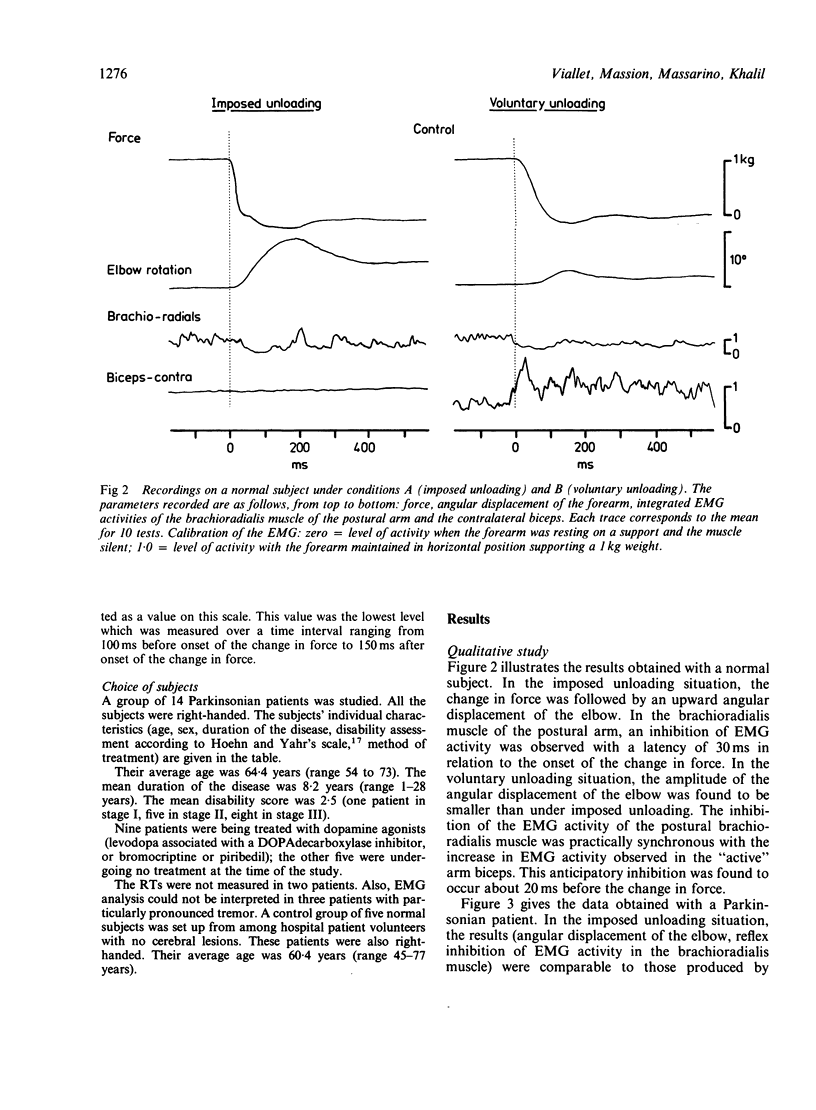
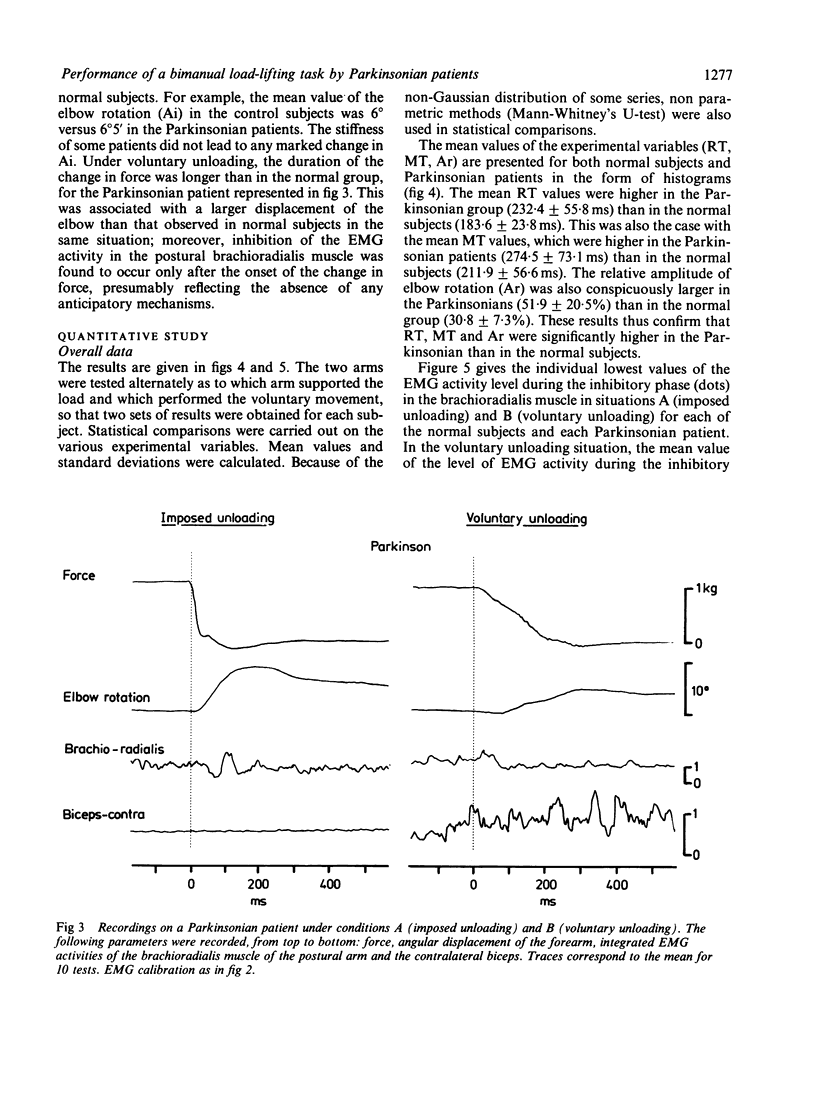

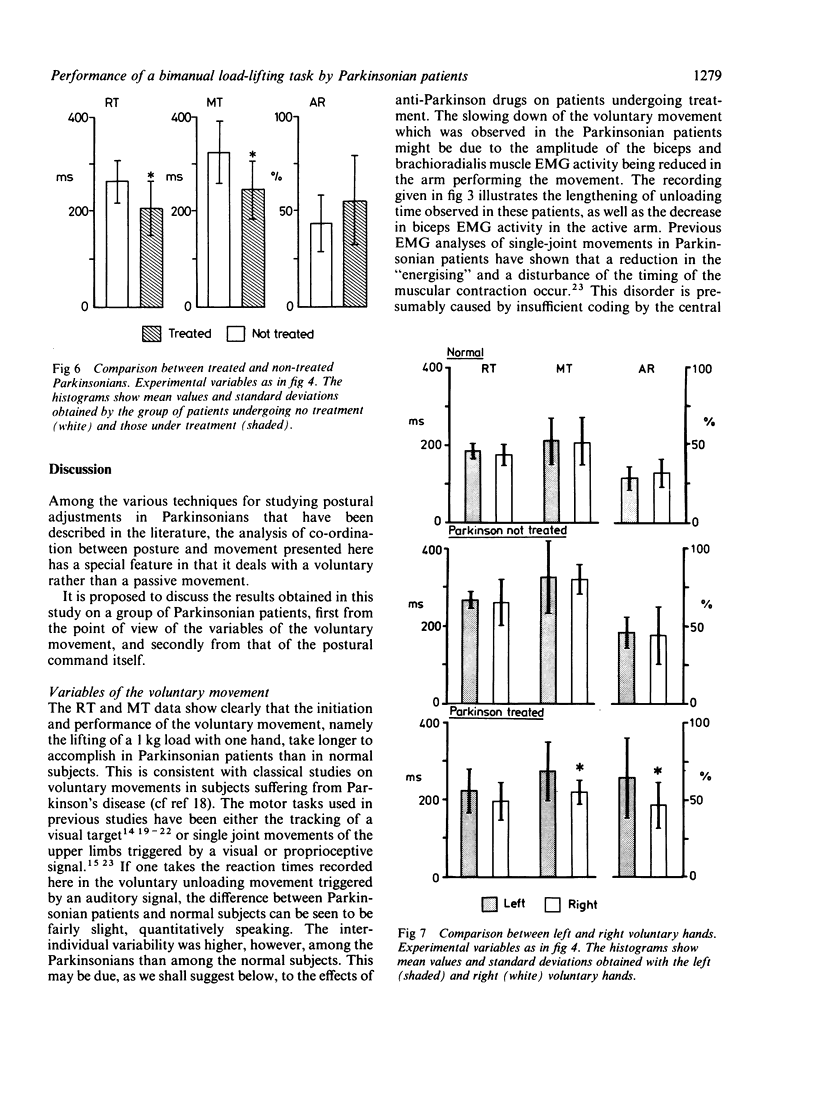
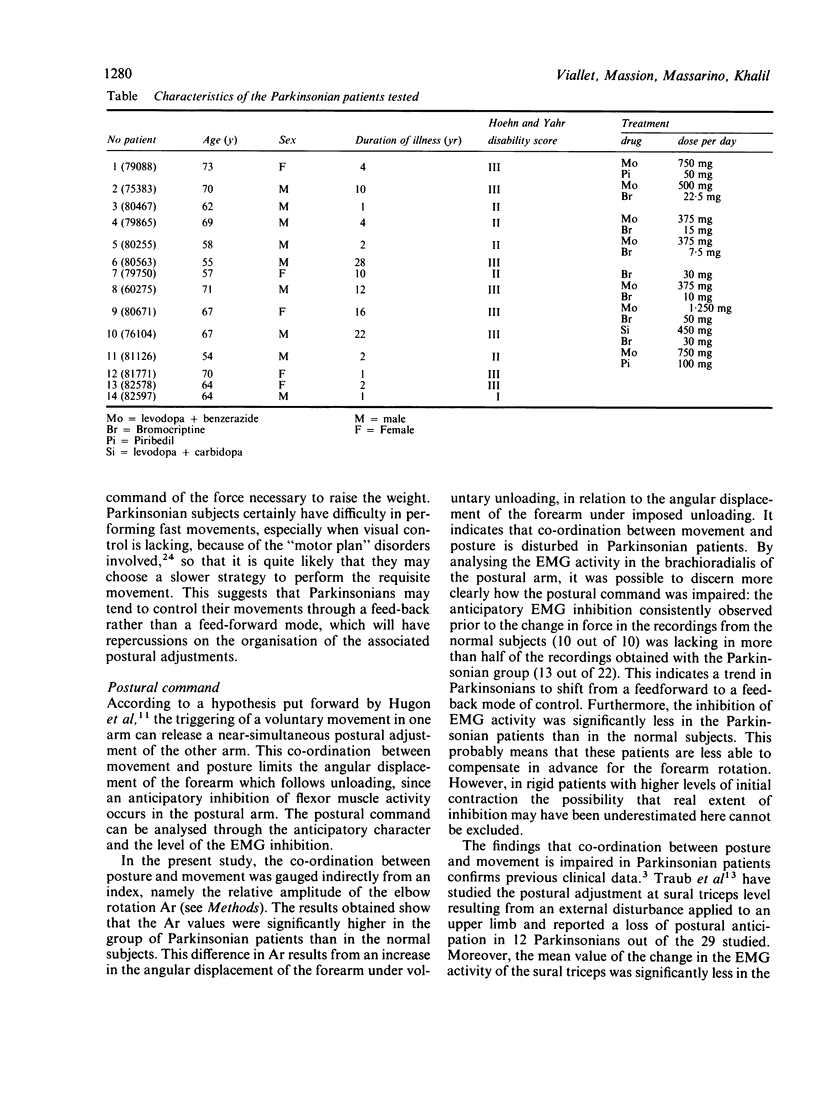
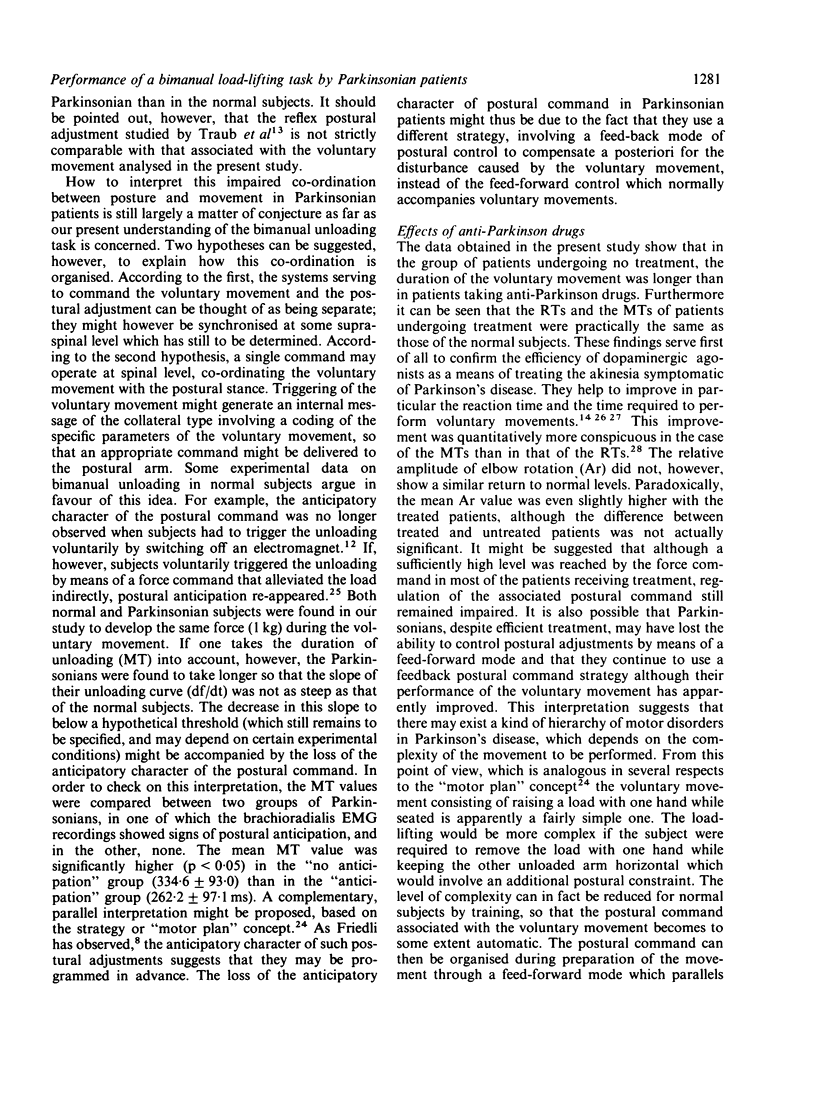

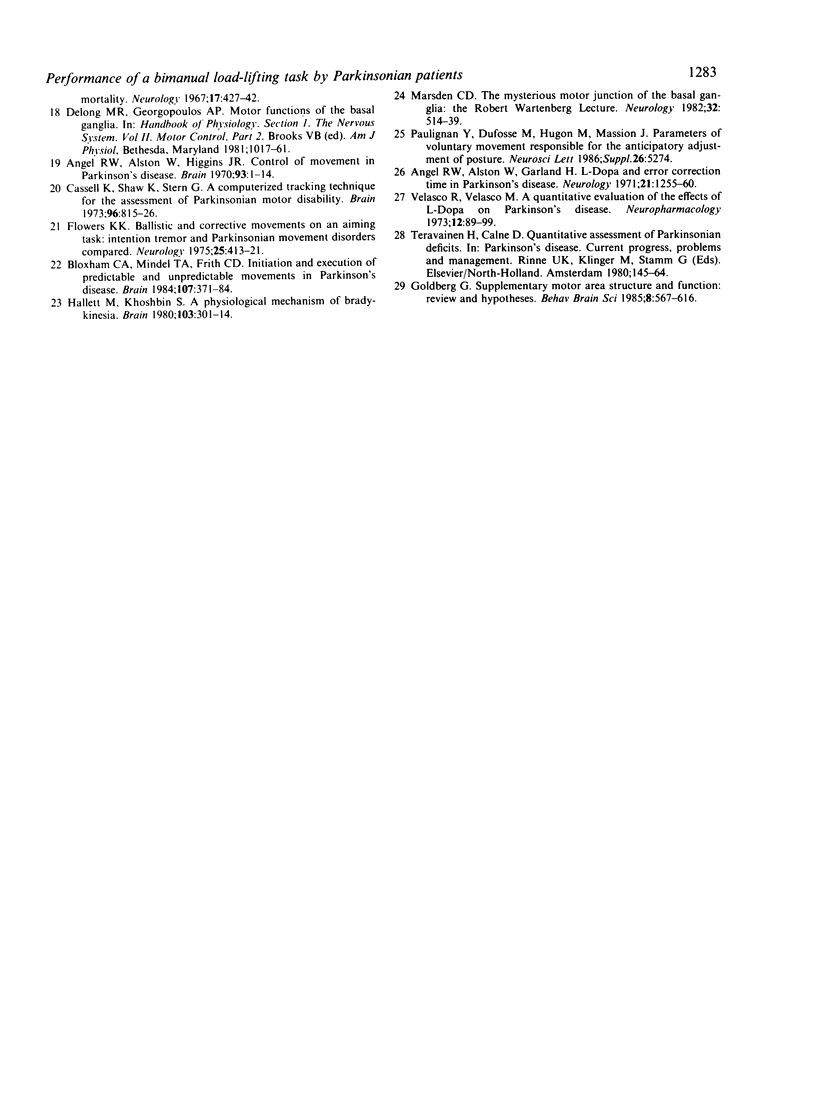
Selected References
These references are in PubMed. This may not be the complete list of references from this article.
- Angel R. W., Alston W., Garland H. L-dopa and error correction time in Parkinson's disease. Neurology. 1971 Dec;21(12):1255–1260. doi: 10.1212/wnl.21.12.1255. [DOI] [PubMed] [Google Scholar]
- Angel R. W., Alston W., Higgins J. R. Control of movement in Parkinson's disease. Brain. 1970;93(1):1–14. doi: 10.1093/brain/93.1.1. [DOI] [PubMed] [Google Scholar]
- Bloxham C. A., Mindel T. A., Frith C. D. Initiation and execution of predictable and unpredictable movements in Parkinson's disease. Brain. 1984 Jun;107(Pt 2):371–384. doi: 10.1093/brain/107.2.371. [DOI] [PubMed] [Google Scholar]
- Cassell K., Shaw K., Stern G. A computerised tracking technique for the assessment of Parkinsonian motor disabilities. Brain. 1973 Dec;96(4):815–826. doi: 10.1093/brain/96.4.815. [DOI] [PubMed] [Google Scholar]
- Cordo P. J., Nashner L. M. Properties of postural adjustments associated with rapid arm movements. J Neurophysiol. 1982 Feb;47(2):287–302. doi: 10.1152/jn.1982.47.2.287. [DOI] [PubMed] [Google Scholar]
- DRAPER I. T., JOHNS R. J. THE DISORDERED MOVEMENT IN PARKINSONISM AND THE EFFECT OF DRUG TREATMENT. Bull Johns Hopkins Hosp. 1964 Dec;115:465–480. [PubMed] [Google Scholar]
- Dufossé M., Hugon M., Massion J. Postural forearm changes induced by predictable in time or voluntary triggered unloading in man. Exp Brain Res. 1985;60(2):330–334. doi: 10.1007/BF00235928. [DOI] [PubMed] [Google Scholar]
- Evarts E. V., Teräväinen H., Calne D. B. Reaction time in Parkinson's disease. Brain. 1981 Mar;104(Pt 1):167–186. doi: 10.1093/brain/104.1.167. [DOI] [PubMed] [Google Scholar]
- Flowers K. Ballistic and corrective movements on an aiming task. Intention tremor and parkinsonian movement disorders compared. Neurology. 1975 May;25(5):413–421. doi: 10.1212/wnl.25.5.413. [DOI] [PubMed] [Google Scholar]
- Hallett M., Khoshbin S. A physiological mechanism of bradykinesia. Brain. 1980 Jun;103(2):301–314. doi: 10.1093/brain/103.2.301. [DOI] [PubMed] [Google Scholar]
- Hoehn M. M., Yahr M. D. Parkinsonism: onset, progression and mortality. Neurology. 1967 May;17(5):427–442. doi: 10.1212/wnl.17.5.427. [DOI] [PubMed] [Google Scholar]
- Hugon M., Massion J., Wiesendanger M. Anticipatory postural changes induced by active unloading and comparison with passive unloading in man. Pflugers Arch. 1982 Jun;393(4):292–296. doi: 10.1007/BF00581412. [DOI] [PubMed] [Google Scholar]
- Marsden C. D., Merton P. A., Morton H. B. Human postural responses. Brain. 1981 Sep;104(3):513–534. doi: 10.1093/brain/104.3.513. [DOI] [PubMed] [Google Scholar]
- Massion J. Postural changes accompanying voluntary movements. Normal and pathological aspects. Hum Neurobiol. 1984;2(4):261–267. [PubMed] [Google Scholar]
- Tan E. T., Lambie D. G., Johnson R. H., Whiteside E. A. Parasympathetic denervation of the iris in alcoholics with vagal neuropathy. J Neurol Neurosurg Psychiatry. 1984 Jan;47(1):61–64. doi: 10.1136/jnnp.47.1.61. [DOI] [PMC free article] [PubMed] [Google Scholar]
- Traub M. M., Rothwell J. C., Marsden C. D. Anticipatory postural reflexes in Parkinson's disease and other akinetic-rigid syndromes and in cerebellar ataxia. Brain. 1980 Jun;103(2):393–412. doi: 10.1093/brain/103.2.393. [DOI] [PubMed] [Google Scholar]
- Yokochi F., Nakamura R., Narabayashi H. Reaction time of patients with Parkinson's disease, with reference to asymmetry of neurological signs. J Neurol Neurosurg Psychiatry. 1985 Jul;48(7):702–705. doi: 10.1136/jnnp.48.7.702. [DOI] [PMC free article] [PubMed] [Google Scholar]


